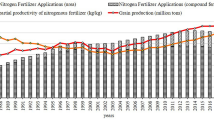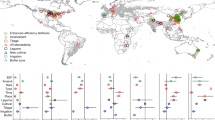Abstract
Nitrogen (N) flows associated with agricultural practices and environmental N risk, which is an index of environmental impact, in Japan from 1980 to 1997 were estimated, and the effect of improvement plans for reducing environmental N risk was simulated for two important prefectures. Recent trends have shown that the input of chemical fertilizer and manure is lower compared to crop production, which is also lower. Environmental N risk peaked in 1985 then became lower, and its content changed. Residual N on farmland, defined as N inputs onto farmland (chemical fertilizer, etc.) minus N outputs from farmland (crop uptake, etc.), peaked in 1985, then decreased, although non-utilized livestock excreta increased during the period. To simulate reduction of the environmental N risk, two prefectures that had high applications of chemical fertilizer and high livestock excreta production were selected. Simulated improvement plans were based on the results of past studies, such as low inputs of chemical fertilizer in crop production, substitution of chemical fertilizer by livestock excreta and/or active use of livestock excreta in forage production. Incorporation of these methods was successful in reducing environmental risk in those prefectures, although prefectures that had a large amount of livestock excreta could not find any effective improvement plan, due to lack of appropriate local land use.
Similar content being viewed by others
References
Ao H & Inagaki T (2000) The effect of decrease in nitrate leach from tea field by using coated urea fertilizer in labor saving cultivation. Jap J Soil Sci Plant Nutr 71: 545–553 (in Japanese)
Crop Production Division (1984) Material for Rice Production, 246–248. MAFF, Tokyo, Japan (in Japanese)
Crop Production Division (1986) Material for Rice Production, 236–238. MAFF, Tokyo, Japan (in Japanese)
Crop Production Division (1991) Material for Rice Production, 341–345. MAFF, Tokyo, Japan (in Japanese)
Crop Production Division (1998) Material for Rice Production, 205–206. MAFF, Tokyo, Japan (in Japanese)
Fertilizer and Farm Machinery Division (1986) In: Pocket Fertilizer Handbook, pp 47. Norin Toukei Kyoukai, Tokyo, Japan (in Japanese)
Fertilizer and Farm Machinery Division (1987) In: Pocket Fertilizer Handbook, pp 47. Norin Toukei Kyoukai, Tokyo, Japan (in Japanese)
Fertilizer and Farm Machinery Division (1992) In: Pocket Fertilizer Handbook, pp 47. Norin Toukei Kyoukai, Tokyo, Japan (in Japanese)
Fertilizer and Farm Machinery Division (2000) In: Pocket Fertilizer Handbook, pp 48. Norin Toukei Kyoukai, Tokyo, Japan (in Japanese)
Furuya S (1995) Innovation of fertilizer application by using controlled-release fertilizers. 4. Coating fertilizer application technique for fruit trees. Jap J Soil Sci Plant Nutr 66: 574–580 (in Japanese)
Harada Y (1992) Recycling of livestock wastes. Jap J Agric Syst Soc 8: 44–58 (in Japanese with English summary)
Howarth RW (1998) An assessment of human influences on fluxes of nitrogen from the terrestrial landscape to the estuaries and continental shelves of the North Atlantic Ocean. Nutr Cycl Agroecosyst 52: 213–223
Ibaraki Prefecture Agriculture, Forestry and Fisheries Division (1995) In: Guideline for Sustainable Agricultural Production. Ed. Ibaraki prefecture. pp 1–95. Ibaraki prefecture, Japan (in Japanese)
Iwate Agricultural Research Center (1997) Report of advanced utilization farming method of livestock feces. In: Ed. Iwate Prefecture. pp 11–19. Iwate Prefecture, Japan (in Japanese)
Kawashima H (1996) Food supply and the nitrogen cycling in Japan. Environ Sci 9: 27–33. (in Japanese with English summary)
Kitamura H & Imai K (1995) Innovation of fertilizer application by using controlled-release fertilizers. 1. The method of non-split application of fertilizer in trans-planting of rice. Jap J Soil Sci and Plant Nutr 66: 574–580 (in Japanese)
Kumazawa K (1999) Present state of nitrate pollution in ground water. Jap J Soil Sci Plant Nutr 70: 207–213 (in Japanese)
MAFF Research Council (1994) Model examples of agricultural technique systems for environmental conservation. pp 83–204. MAFF, Tokyo, Japan (in Japanese)
Matsumoto N, Mishima S, Oda, K & Hakamata, T (1996) Evaluation of the sustainability of nitrogen flow systems in a rural area. In: Sasaki H, Saito I, Tabayashi A & Morimoto T (eds), Geographical Perspectives on Sustainable Rural Systems, pp 153–162. Kaisei Publication, Tokyo, Japan (in Japanese)
Matsumoto N, Mishima S, Oda K & Hakamata T (2000) Evaluation of nitrogen flows from a manure supply system in Satomi Village, Ibaraki, Japan. J Jap Agric Syst Soc 16: 62–73. (in Japanese with English summary)
Mishima S, Matsumoto N & Oda K (1999) Nitrogen flow associated with agricultural practices and environmental risk in Japan. Soil Sci Plant Nutr 45: 881–889.
Miyata S (2000) Present state and problems on recycling of organic resources. In: Future View of Recycle of Organic Resources on Agriculture. Ed. National Institute of Agroenvironmental Sciences, pp 1–52. Yokendo, Tokyo, Japan (in Japanese)
Miyazawa M (1979) Management of northern grassland in cool climate area. In: Nosangyosonbunkakyokai (ed) Systems of Agricultural Techniques Animal Industry Part 7, pp 243–262. Nosangyosonbunkakyokai, Tokyo, Japan (in Japanese)
National Astronomical Observatory (1998) Chronological Scientific Tables, pp 210–211. Maruzen, Tokyo, Japan (in Japanese)
Nonaka K, Shibuya G, Kondo H, Kawauchi I & Yamamoto K (1998) Capacity of slurry on green sorghum-green rye rotation system. The new information of grass and forage production results. 13: 55–56 (in Japanese)
OECD 1997 Agricultural nutrient use. In: Environmental Indicators for Agriculture. Ed. OECD pp 24–27. OECD Publications, Paris, France
OECD (1999) Agricultural nutrient use. In: Environmental Indicators for Agriculture, Volume 1, Concepts and Framework, Ed. OECD, pp 19–21. OECD Publications, Paris, France
e.pdf
Ookita T (1996) Acid rain in Japan. In: Ookita T (ed) Acid rain. p 131. Hakuyusha, Tokyo, Japan (in Japanese)
Owa N (1996) Nutrient balance on crop production in Japan. In: Kanto-Tokai Nogyo (ed) New Movement on Effective use of Fertilizer, p p1–15. National Agricultural Reserch Center, Tsukuba, Japan (in Japanese)
Shiga (1994) Capacity of organic resource application to farmland and livestock wastes. Research and development center for dairy farming, Sapporo, Japan (in Japanese)
Smil V (1999) Ntrogen in crop production: an account of global flows. Global Boilog Cycles 13: 647–662
Statistics and Information Department (1982a) The 57th Statistical Yearbook of Ministry of Agriculture Forestry and Fisheries, pp 6–143. Norin Tokei Kyokai, Tokyo, Japan
Statistics and Information Department (1982b) Production Cost of Livestock Products, pp 38–166. Norin Tokei Kyokai, Tokyo, Japan (in Japanese)
Statistics and Information Department (1987a) The 62nd Statistical Yearbook of Ministry of Agriculture Forestry and Fisheries, pp 66–143. Norin Tokei Kyokai, Tokyo, Japan
Statistics and Information Department (1987b) Production Cost of Livestock Products, pp 36–160. Norin Tokei Kyokai, Tokyo, Japan (in Japanese)
Statistics and Information Department (1992a) The 67th Statistical Yearbook of Ministry of Agriculture Forestry and Fisheries, pp 66–143. Norin Tokei Kyokai, Tokyo, Japan
Statistics and Information Department (1992b) Production Cost of Livestock Products, pp 36–174. Norin Tokei Kyokai, Tokyo, Japan (in Japanese)
Statistics and Information Department (1999a) The 74th Statistical Yearbook of Ministry of Agriculture Forestry and Fisheries. pp 66–143. Norin Tokei Kyokai, Tokyo, Japan
Statistics and Information Department (1999b) Production Cost of Livestock Products, pp 30–171. Norin Tokei Kyokai, Tokyo, Japan (in Japanese)
Tamminga G & Wijnands J (1991) Animal waste problems in the Netherlands (Chapter 7). Farmingand the countryside. In: An Economic Analysis External Costs and Benefits, pp 117–136. C.A.B. INTERNATIONAL, Oxford, UK
Tsuki M & Harada Y (1997) Livestock excreta production in Japan and future themes. In: Nishio M (ed) Environment conservation and new livestock production, pp 15–29. Norinsuisangijustukyokai, Tokyo, Japan (in Japanese)
Tsuruta H (2000) Interaction between greenhouse gases and soil ecosystem. 3. The estimation of nitrous oxide from nitrogenous compounds produced by human activity. Jap J Soil Sci Plant Nutr 71: 554–564 (in Japanese)
Uozumi J, Yoshimura Y & Kurokawa S (1999a) Nitrogen balance and forage yields under high slurry input. The new information of grass and forage production results. 14: 39–40 (in Japanese)
Uozumi J, Yoshimura Y & Kurokawa S (1999b) The movement of NO3-N in soil water under slurry amendment in relation to sorghum growth. The new information of grass and forage production results. 14: 41–42 (in Japanese)
Xing GX & Zhu ZL (2000) An assessment of N loss from agricultural fields to the environment in China. Nutr Cycling Agroecosyst 57: 67–73
Yamaguchi T (1997a) Treatment and utilization of animal wastes (1). J Agric Sci 52: 299–303 (in Japanese)
Yamaguchi T (1997b) Treatment and utilization of animal wastes (2). J Agric Sci 52: 354–356 (in Japanese)
Yatazawa M (1978) Agro-Ecosystems in Japan. In: Frissel MJ (ed) Cycling of Mineral Nutrients in Agricultural Ecosystems, pp 167–179. Elsevier Scientific Pub. Co., Amsterdam, the Netherlands
Zebarth GJ, Paule JW & Van Kleeck R (1999) The effect of nitrogen management in agricultural production on water and air quality: evaluation on regional scale. Agric Ecosyst & Environ 72: 35–52
Zebarth BJ, Hii B, Liebscher H, Chaipperfield K, Paul JW, Grove G & Szeto SY (1998) Agricultural land use practices and nitrate contamination in the Abbotsford aquiver, British Columbia, Canada. Agric Ecosyst Environ 69: 99–112
Author information
Authors and Affiliations
Rights and permissions
About this article
Cite this article
Mishima, Si. The recent trend of agricultural nitrogen flow in Japan and improvement plans. Nutrient Cycling in Agroecosystems 63, 151–163 (2002). https://doi.org/10.1023/A:1021111117622
Issue Date:
DOI: https://doi.org/10.1023/A:1021111117622




